Prickly Comfrey
= Symphytum Asperum
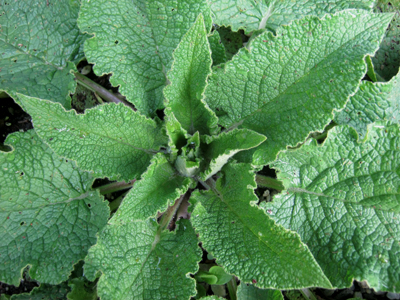
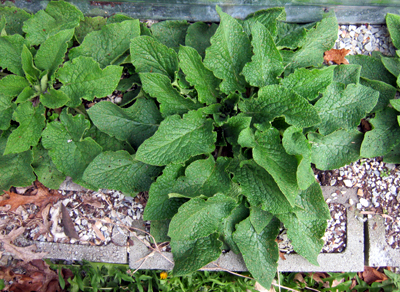
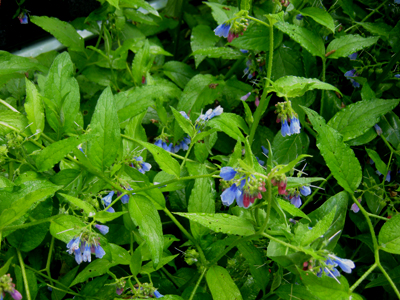
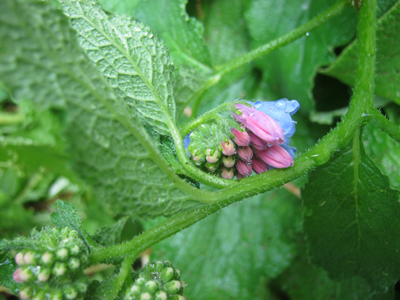

In the above photo the top left flower is Prickly comfrey. The other flowers are hybrids of 1/2 Prickley and 1/2 Common comfrey.
In the spring Common comfrey blooms earlier than Prickly comfrey.
Prickly comfrey blue flowers fade to lighter shades as it withers away.
Prickley comfrey is bushier than Common comfrey.
|
Symphytum
Asperum or Asperrimum
Description
of Prickly or Rough Comfrey
Symphytum asperrimum is a native of the Caucasus. The Caucasus Mountains are located at the border of Europe and Asia, between the Black Sea and Caspian Sea and occupied by Russia, Georgia, Azerbaijan, and Armenia.
The flower-stem leaves are opposite. Asperriumum means roughest. Its leaves and stems are hairy, covered with short, stiff bristles. The flowers are pink or blue. ‘The Dictionary of Gardening’ by the Royal Horticultural Society, 1952, recommends it as a plant good for a wild garden.
“Symphytum Asperrimum, Prickly Comfrey. Class and Order: Pentandria Monogynia.
This species of Symphytum, a native of Caucasus, is by far the largest of the genus, growing to the height of five feet (1.5 meters), and is really an ornamental, hardy perennial, which will thrive in any soil or situation.
It differs from Symphytum orientale not only in stature (height) and in the greater roughness of the leaves, but in the stems being not merely hispid, but covered with small curved prickles; the floral leaves are constantly opposite, which is seldom the case in orientale. The nectaries in both are flat, not fistulous (hollow).
According to Mr. Donn, it was introduced in 1801 (to England), we believe, by Mr. Loddiges, of Hackney, England.
Our drawing (plate) 929 was taken at the Botanic Garden at Brompton, London, where we have observed it some years in the greatest vigour.
Propagated by parting its roots or by seeds.”
-‘Curtis's Botanical Magazine; or, Flower-Garden Displayed in which the Most Ornamental Foreign Plants, Cultivated in the Open Ground, the Green-House, and the Stove, are Accurately Represented in their Natural Colours, Volumes 23-24’ by John Sims, M.D., Fellow of the Linnean Society, London, England, 1806.
History of Prickly Comfrey in Great Britain, Ireland and United States
“Caucasian Prickly Comfrey (Symphytum asperrimum):
This perennial plant, introduced into England in the year 1790, has prominently attracted public attention during the last few years, as a forage plant, to be grown on a large scale, as a food for horned cattle, horses, sheep, pigs, and all kinds of poultry.
Its wonderfully quick growth, and fine cropping qualities, and its power of resisting drought, are making it a favourite with farmers and dairymen. With but little labour, beyond cutting the green leaves, Prickly Comfrey will yield, year after year, from 60 to 150 tons of forage per acre.
It comes up early in the spring, and may usually be cut for the first time in April, and will then continue yielding through the hottest and dryest summers, until the hard winter frosts cut down its foliage. It will grow well on clay, even the thickest and coldest, on loam, gravel, or pure sand.”
-‘New Commercial Plants with Directions How to Grow Them to the Best Advantage, No. 1 (1878) and No. 3 (1880)’ by Thomas Christy, F.L.S. (Fellow of Linnaean Society), London, England. Number 1 includes Caucasian Prickly Comfrey pages 14-16. Number 3 includes Prickly Comfrey pages 11-14. Includes ‘Caucasian Prickly Comfrey’ and ‘Russian Comfrey’ advertisements.
|
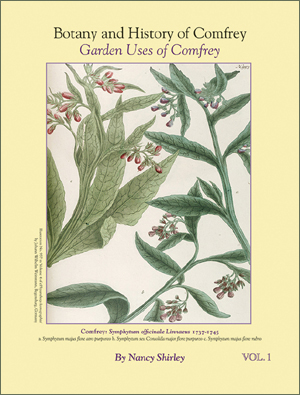
Find out
more about Prickly Comfrey in chapter 7 of Botany
and History of Comfrey; Garden Uses of Comfrey
Prickly or Rough Comfrey
Current Botanical Nomenclature
Accepted Name or Synonym
Symphytum asperum Lepech.
Symphytum asperum var. armeniacum (Bucknall) Kurtto
Symphytum asperrimum Donn ex Sims
Symphytum armeniacum Bucknall.
Symphytum echinatum Ledeb
Symphytum peregrinum Ledeb.
Not Accepted Name
Symphytum asperrimum Donn
Symphytum asperrimum Sims
Symphytum asperrimum Urv. = Symphytum anatolicum Boiss.
Symphytum majus Gueldenst.
Symphytum majus Gueldenst. ex Ledeb.
|
Symphytum
Asperum Growth Patterns and Yield
“Prickly Comfrey differs morphologically, genetically and chemotaxonomically from the widely distributed Common Comfrey (Symphytum officinale L.), less widely distributed Russian Comfrey (Symphytum x uplandicum Nym.), and Tuber Comfrey (Symphytum tuberosum L.), a rare newcomer in southern Finland.
Prickly Comfrey (Symphytum asperum Lep.) differs from other Comfrey species in flower color and the sizes of organs, more vigorous growth (*Mossberg and Stenberg, 2005), DNA, ploidy level and chemotaxonomic markers (Gadella and Kliphuis, 1975, 1978; Gadella et al., 1983; Jaarsma et al., 1989, 1990; Ozcan, 2010; Barbakadze et al., 2011).
Among the Comfreys mentioned, Prickly Comfrey has the smallest chromosome number (2n = 32) and contains echimidine alkaloid but not isobauerenol, which is typically found in Common Comfrey.
Russian Comfrey contains both of these alkaloids and is a cross hybrid between Prickly and Common Comfrey (Jaarsma et al., 1989).
Prickly Comfrey (Symphytum asperum Lep.) is native to the Caucasus and Iran (Mossberg and Stenberg, 2005) but has been naturalized in many parts of Asia, Europe, America, Africa and Australia, especially in former British colonies (**Tutin, 1956; ***Wade, 1958).”
-‘Phenomena, Biometrics and Canopy Behavior of Prickly Comfrey (Symphytum Asperum Lep., Boraginaceae in a Long-Term Experiment’ by Tadeusz Aniszewski, Research and Teaching Laboratory of Applied Botany, University of Eastern Finland, Acta Biologica Cracoviensia, Series Botanica (Biological Association Cracoviensia, Botanical Series) 54/1, pages 121-128, 2012.
(* -’Grand Guide to Northern Plants’ or ‘Extensive Manual of the North Flora’ by B. Mossberg and L. Stenberg; Tammi, Helsinki, Finland, 2005, page 928. In Finnish.)
(** -‘The Genus Symphytum in Britain’ by T.G. Tutin, University College of Leicester, England; Watsonia: Journal of the Botanical Society of the British Isles, Volume 3, pages 280-281, February 1956.)
(*** -‘The History of Symphytum Asperum Lepech. and S. x Uplandicum in Britain’ by A.E. Wade, Department of Botany, National Museum of Wales, Watsonia, Volume 4, pages 117-118, 1958. Watsonia was the journal of the ‘Botanical Society of Britain and Ireland’ from 1949 to 2010. It is now called ‘New Journal of Botany’.)
|
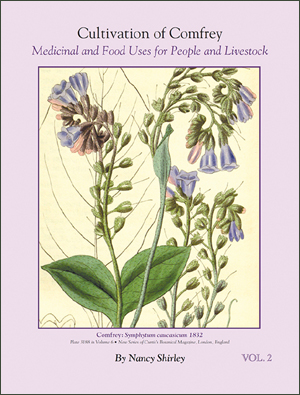
Find out
more about Prickly Comfrey in chapter 20 of Cultivation
of Comfrey: Medicinal and Food Uses for People and Livetstock
Prickly or Rough Comfrey
Current Botanical Nomenclature
Accepted Name or Synonym
Symphytum asperum Lepech.
Symphytum asperum var. armeniacum (Bucknall) Kurtto
Symphytum asperrimum Donn ex Sims
Symphytum armeniacum Bucknall.
Symphytum echinatum Ledeb
Symphytum peregrinum Ledeb.
Not Accepted Name
Symphytum asperrimum Donn
Symphytum asperrimum Sims
Symphytum asperrimum Urv. =Symphytum anatolicum Boiss.
Symphytum majus Gueldenst.
Symphytum majus Gueldenst. ex Ledeb.
|
Prickly Comfrey as a Forage Crop, 1876
“If a quarter of an acre of ground is set apart in a suburban garden, sufficient forage can be obtained to maintain a cow and a horse all the year round, and keep the family in good, rich, wholesome milk and butter of superior quality to what is obtained from the grocer.
Gentlemen who have grown Comfrey for twenty years in England, say they get better and richer milk from their cows, and a higher price for their butter.
A writer in the ‘The Field’ of December 17th, 1870, states: ‘It is nearly forty years since my attention was directed to Prickly Comfrey; its excellence as a food for cattle, its specialties the chief of which is its rapid and continuous reproduction.
I procurred (obtained) in the year I spoke of (about 1832) twenty-five (root) sets of the Prickly Comfrey taken immediately from the plant grown on the spot.
I know nothing at all comparable to it to set before cattle for nourishment. The weight of each leaf will be somewhat more than an ounce (28 grams).
When the whole crown (top roots with leaf buds) was taken at once, it reproduced in the short space of ten or twelve days in the summer time, and in a fortnight (2 weeks) or little more in late spring and autumn.
Mr. W. Doubleday ‘thinks the Symphytum asperrimum (Prickly Comfrey) will prove a highly valuable plant for India, quite a mine of wealth for the farmers who keep cattle. Its extreme luxuriance, and its power of withstanding a long drought, mark it out for such a climate’.
If this opinion is worth anything, and I submit that it is, what a valuable plant Comfrey will be in New South Wales (Australia). A few acres on a large run will keep cattle and sheep from starving, but if grown in sufficient quantities, will prevent them losing condition.”
-‘Prickly Comfrey: Its History, Cultivation, Extraordinary Production, and Uses: A Letter Addressed to His Excellency Sir Hercules Robinson, President of the Agricultural Society of New South Wales’ by Arthur T. Holroyd, Sydney, Australia, 1876, pages 5-6.
(‘The Field’ is the world's oldest country and field sports magazine, having been published continuously in England since 1853.)
|


|
Prickly Comfrey in March
These 2 photos are Prickley comfrey in mid-March.
The photo with concrete blocks shows size.
|
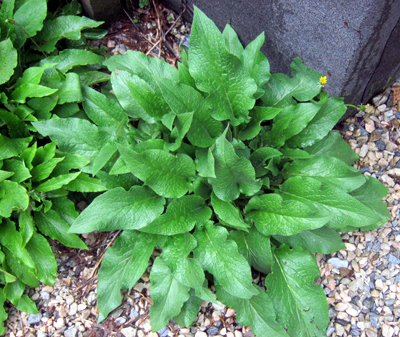
|
Prickly Comfrey in April
This photo
is a 2-year-old plant in mid-April. On the top right is a partly closed
dandelion flower.
|


|
Prickly Comfrey in May
Beautiful blue Prickley Comfrey flowers and pink buds.
|
|











